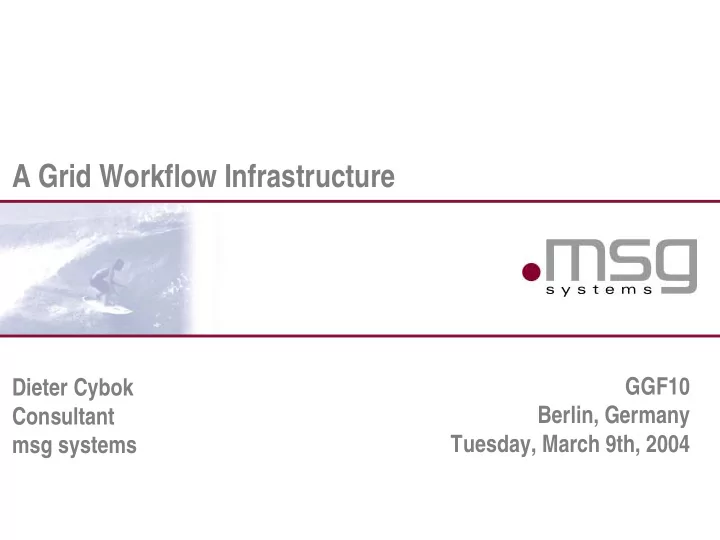

A Grid Workflow Infrastructure GGF10 Dieter Cybok Berlin, Germany Consultant Tuesday, March 9th, 2004 msg systems 1 A Dieter Cybok, msg systems
Motivation • Scientific applications often require the creation of complex collaborative workflows • Many e-Scientists lack the necessary low-level expertise to utilize the current generation of Grid toolkits • Documented workflow specification is beneficial for modelling and managing scientific processes; processes can be easily reused, modified and shared � Making live of e-Scientists easier 2 A Dieter Cybok, msg systems
Grid Workflow - Patterns • Workflow Patterns – Reusing results from workflow research – Defining relevant set of workflow patterns relevant to e-Science applications A A B A B A B parallel multi sequence loop split choice 3 A Dieter Cybok, msg systems
Grid Workflow - Approaches • Orchestration – Describes business logic and execution order – Executable processes – One central workflow engine activity 1 Grid Grid service service activity 2 W W S S D flow D L L Grid Grid service activity 3 activity 5 service activity 4 activity 6 4 A Dieter Cybok, msg systems
Grid Workflow - Approaches • Choreography – Sequence of messages that involve multiple services – Public message exchanges that occur between Grid services – Services involved describe the part they play in the interaction Grid service Grid Grid service service Grid service 5 A Dieter Cybok, msg systems
Grid Workflow - Requirements • Web services workflow management requirements: – Managing transactional integrity – Compensating transactions – Managing exceptions • Additional grid workflow requirements: – Dealing with large amounts of data – Life cycle management 6 A Dieter Cybok, msg systems
Grid Workflow Infrastructure Grid Workflow Infrastructure G rid W orkflow Workflow E xecution Engine L anguage GT3 Technology 7 A Dieter Cybok, msg systems
Grid Workflow Execution Language • We have considered both, BPEL4WS and WSCI as the base for GWEL • Reasons for choosing orchestration/BPEL4WS: – Definition of end-to-end processes – Existing Grid services can be used – Central workflow engine • GWEL: – XML based – Elements and concepts of BPEL4WS are reused 8 A Dieter Cybok, msg systems
Grid Workflow Execution Language Name, Target Namespace GWEL definition Factory Model List of Factories: Name, Handle Data Model List of Data Sources: Name, Handle Variables List of Variables: Name, messageType Fault Handling Model List of Fault Handlers: Name, Variable Activity Model Instance Lifecycle Model Instance Creation List of Instance Creators: Name, Factory Event Handling Events List of Events: Type, PortTypeName, Operation Activity Model Activity Model List of Activities: Name, portType, operation, Control Flow variable, data source, data sink 9 A Dieter Cybok, msg systems
Workflow Engine GWEL • Architecture is based on the client file workflow reference model workflow • Prototypical implementation engine with Java control and small amounts of data service 2 service 3 service 1 data data data data base base base base 10 A Dieter Cybok, msg systems
Underlying Technology • OGSA – Concept for a framework of services that support Grid functionalities • OGSI – Technical specification of the concepts described in OGSA – GWI operates on OGSI-based Grid services • GT3 – Implementation of OGSI and OGSA – GWI operates on GT 3.0 11 A Dieter Cybok, msg systems
Case Study • Obtaining Bayesian Networks form data – Using the unweighted L1 metric spanning tree algorithm – Computationally expensive GWEL client file • Workflow: workflow 1. L1 service reads in data engine 2. Unweighted L1 metric measure is computed 3. Intermediate results are stored 2 5 4. Sort service reads in intermediate results L1 service sort service 5. Intermediate results are sorted 6 1 3 4 6. Sorting final results data data data base base base 12 A Dieter Cybok, msg systems
Case Study – GWEL document < workflow name="Simple_Workflow" … > < factoryLinks > … </factoryLinks> workflow.gwel < dataLinks > … </dataLinks> < lifecycle > < createInstance instance_name="l1_instance"> <factoryLink name="L1"/> </createInstance> … <eventHandlers> < onNotification instance_name="l1_instance" portType="NotificationL1PortType" operation="computeL1"> < destroyInstance instance_name="l1_instance"> <factoryLink name="L1"/> </destroyInstance> </onNotification> … </eventHandlers> </lifecycle> < controlflow > < sequence name="sequence1"> < invoke instance_name="l1_instance" portType="l1_port" operation="computeL1" dataInFrom="raw_data_input_db" dataOutTo= "l1_result_db"/> … </sequence> </controlflow> </workflow> 13 A Dieter Cybok, msg systems
Case Study – Activity Diagram Client Workflow Engine Workflow Engine instance L1 factory L1 instance Sort factory Sort instance factory WFE Sort L1 Sort client WFE L1 instance instance factory instance fact. factory call create return GSH to workflow workflow the client factory engine instance create Sort return GSH to service the workflow parse instance engine instance submit GWEL GWEL document create L1 return GSH to document service the workflow instance engine instance store L1 instance GSH store Sort instance GSH input data, invoke L1 compute it instance and store it destroy L1 send instance notification destroy Sort send instance notification input data, invoke compute it Sort and store it instance 14 A Dieter Cybok, msg systems
Conclusions • e-Scientists need a generally applicable grid workflow infrastructure – Specifying processes graphically – Locating available services easily – Plugging together services automatically • Our solution – Prototypical infrastructure – Feasibility study – Introduces core components • Future work – Much more needs to be done – Performance issues – Implementation of new technologies such as WSRF 15 A Dieter Cybok, msg systems
Acknowledgements Most of this work was done at Imperial College London under the supervision of Dr. Steven Newhouse and Dr. Anthony Mayer 16 A Dieter Cybok, msg systems
Recommend
More recommend